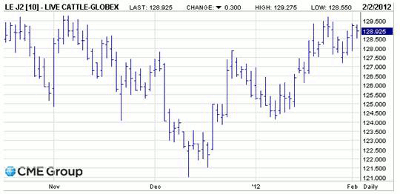Fundamental and technical factors predict potential for live cattle prices to again surpass all-time highs this year, giving traders the ability to go long the futures to capitalize.
The cattle market is very inelastic due to the breeding characteristics that control supply. The gestation period for cattle is approximately 40 weeks. Obviously, cows can be brought to market or held back for breeding. This results in cattle farmers deciding whether the current market price justifies the instant gratification of cashing out and bringing cattle to market, or holding them back for breeding to satisfy future demand.
Last year, the cattle market set an all-time high just over $131. I believe we will breach that level to set new highs again in 2012.
Last year’s all-time highs were based on growing global demand, and this year shows little in the way of slowing down. Normally, the solid global foundation of growing demand would see breeding herds built up to satisfy the coming years’ needs.
However, last year’s drought in the major cattle-producing regions of the southern plains forced farmers to bring cattle to market and feed lots as grazing land evaporated and feed prices skyrocketed. The result was a decline in US herd sizes in the face of growing demand. This sets the stage for even higher live cattle prices in 2012.
Meat has been measured in per capita supply as long as the USDA has been reporting numbers. This year, it’s expected to be just over 54 pounds. This is down 10% from two years ago, and it’s quite possible that we end up at our lowest rate in over 50 years.
It took some digging, as the USDA data only goes back to 1971, but the next historical level of 54.5 set in 1953 ties right in with the USDA’s expectations. More details include a breeding herd that has declined in size in 13 out of the last 15 years, as well as increasing global demand due to trade agreements with South Korea, Columbia, and Panama.
Finally, there is growing speculation that Japan will end their embargo on US beef, which has been in place since the 2006 mad cow development.
There are two wild cards that may affect demand this year. The first is a global slowdown in the overall economy. The newfound taste for US beef in developing markets is still in its infancy. Therefore, if their purchasing power declines, locally sourced beef substitutes are still readily available.
The second issue is the development of the European bailout. If Greece decides to leave the European Union and revert to the Drachma, we will see a flood of money into the US dollar. This would create a huge pricing issue as US beef would suddenly become very expensive on the open market and may provide the justification for ranchers to pull their animals off of feedlots and place them back into the breeding population.
This leads us to the question, “How high is high?” April live cattle futures are currently trading around $128.50, while the June contract is trading at a $.60 discount. The April contract appears ready to take out the October and November highs just shy of $130.
This would provide a technical trigger of an inverted head-and-shoulders pattern, which provides us with a measured objective around $136. This also ties in well with fundamental analysis by The Hightower Report, which expects a high around $135.
Finally, Jim Hilker’s statistical analysis as head of Michigan State’s Department of Agricultural Economics projects a high end just shy of $137. In the face of the news-driven markets we’ve been forced to trade, it’s nice to return to the old-fashioned simplicity of the laws of supply and demand.
By Andy Waldock of Commodity and Derivative Advisors






















